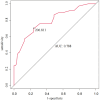Development and validation of a preoperative model for predicting positive proximal margins in adenocarcinoma of the esophagogastric junction and assessing safe margin distance
- PMID: 39720570
- PMCID: PMC11666492
- DOI: 10.3389/fonc.2024.1503728
Development and validation of a preoperative model for predicting positive proximal margins in adenocarcinoma of the esophagogastric junction and assessing safe margin distance
Abstract
Objective: To develop and validate a model for preoperative prediction of positive proximal margins for adenocarcinoma of the esophagogastric junction (AEG) by transabdominal approach, and to analyze the safe margin distances for patients with different risks of positive proximal margins.
Materials and methods: A retrospective analysis was performed on 284 AEG patients who underwent surgery via the transabdominal approach at Hengshui People's Hospital between January 2017 and December 2023. Patients were divided into a training set (n=201, first five years) and a test set (n=83, last two years). Clinicopathologic factors potentially influencing margin status were collected. The synthetic minority oversampling technique (SMOTE) was applied to address class imbalance in the training set. Two nomogram models were developed: one based on the original training set and the other using the SMOTE dataset. The model's performance was compared using the test set, with the area under the curve (AUC) used to evaluate discrimination and the Hosmer-Lemeshow test used for model fit. The best-performing model was used to calculate total scores for the entire cohort, and the optimal cutoff value was determined via the ROC curve. Patients were classified into low- and high-risk groups based on the total score, and optimal margin distances were determined using Youden's index.
Results: The model developed using the SMOTE dataset showed superior AUC for predicting positive proximal margins in the test set compared to the model based on the original training set (0.814 vs. 0.780). Independent predictors of positive proximal margins included Borrmann classification, Lauren classification, cT stage, tumor differentiation, and Siewert classification. The Hosmer-Lemeshow test showed a good model fit (χ² = 5.397, P = 0.612). Using a cutoff total score of 206.811, patients were divided into low-risk (score < 206.811) and high-risk (score ≥ 206.811) groups, with an AUC of 0.788. For the low-risk group, a proximal margin distance of 2.75 cm yielded an AUC of 0.824, with a sensitivity of 54.5%, specificity of 97.9%, and a Youden's index of 0.524. For the high-risk group, a margin distance of 3.85 cm provided an AUC of 0.813, sensitivity of 73.1%, specificity of 80.0%, and a Youden's index of 0.531.
Conclusions: The nomogram may offer a valuable preoperative tool for assessing the risk of positive proximal margins in AEG patients. While it holds the potential to inform surgical decision-making and help determine appropriate margin distances, further validation in larger and more diverse cohorts is needed to confirm its clinical utility.
Keywords: adenocarcinoma; advanced; esophagogastric Junction; positive proximal margin; predictive model.
Copyright © 2024 Guo, Wang, Zhao, Du, Cui and Liu.
Conflict of interest statement
The authors declare that the research was conducted in the absence of any commercial or financial relationships that could be construed as a potential conflict of interest.
Figures





Similar articles
-
[Predictive value of ventricular repolarization heterogeneity parameters for malignant arrhythmias in children with viral myocarditis].Zhonghua Yi Xue Za Zhi. 2025 Mar 25;105(12):912-918. doi: 10.3760/cma.j.cn112137-20241115-02564. Zhonghua Yi Xue Za Zhi. 2025. PMID: 40113416 Chinese.
-
A nomogram for predicting the risk of major postoperative complications for patients with meningioma.Neurosurg Rev. 2023 Oct 31;46(1):288. doi: 10.1007/s10143-023-02198-8. Neurosurg Rev. 2023. PMID: 37907646
-
Construction of a novel nomogram for predicting overall survival in patients with Siewert type II AEG based on LODDS: a study based on the seer database and external validation.Front Oncol. 2024 Jun 7;14:1396339. doi: 10.3389/fonc.2024.1396339. eCollection 2024. Front Oncol. 2024. PMID: 38912066 Free PMC article.
-
An intraoperative nomogram for predicting secondary margin positivity in breast conserving surgery utilizing frozen section analysis.Front Oncol. 2025 Jan 7;14:1366467. doi: 10.3389/fonc.2024.1366467. eCollection 2024. Front Oncol. 2025. PMID: 39839802 Free PMC article.
-
Minimal length of proximal resection margin in adenocarcinoma of the esophagogastric junction: a systematic review of the literature.Updates Surg. 2019 Sep;71(3):401-409. doi: 10.1007/s13304-019-00665-w. Epub 2019 Jun 26. Updates Surg. 2019. PMID: 31243725
Cited by
-
QUESTIONS REGARDING SAMPLING AND VALIDATION METHODS.Shock. 2025 Jun 1;63(6):947. doi: 10.1097/SHK.0000000000002580. Epub 2025 Mar 31. Shock. 2025. PMID: 40202389 No abstract available.
References
-
- Shoji Y, Koyanagi K, Kanamori K, Tajima K, Ogimi M, Yatabe K, et al. . Current status and future perspectives for the treatment of resectable locally advanced esophagogastric junction cancer: A narrative review. World J Gastroenterol. (2023) 29:3758–69. doi: 10.3748/wjg.v29.i24.3758 - DOI - PMC - PubMed
LinkOut - more resources
Full Text Sources

